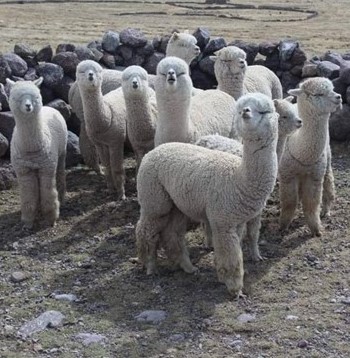Influence of castration on the centesimal composition and cholesterol content of meat from alpacas (Vicugna pacos)
Influencia de la castración en la composición química de la carne de alpacas (Vicugna pacos)

This work is licensed under a Creative Commons Attribution-NonCommercial-ShareAlike 4.0 International License.
Show authors biography
Objetive. Determinate the influence of bilateral castration of young alpacas on the centesimal composition and cholesterol content in muscle tissue of five anatomical regions. Materials and methods. Twenty male animals, 1.5 years old, of the Huacaya breed, were selected, forming two groups of 10 animals: experimental and control. Those in the experimental group underwent bilateral castration and those in the control group remained “whole”. After six months, all animals were slaughtered and muscle tissue samples were taken from five anatomical regions: neck, arm, ribs, loin, and leg. Moisture was determined by oven drying to constant weight, total fat by the Soxhlet method, crude protein by the Kjeldahl method, ashes by muffle calcination at 550˚C and cholesterol by the colorimetric method after fat extraction. with chloroform/methanol (2:1). Results. Fat content is higher in castrated (2.28%) than in intact (1.82%) (P≤0.01) and varies between different anatomical regions (P≤0.05); humidity is higher in intact animals (76.14%) than in castrated ones (75.45%) (P≤0.01), but similar between the different anatomical regions (P>0.05); there are no differences in terms of protein, ash and cholesterol content (P>0.05), with the average being 20.39%, 1.13% and 55.56 mg/100 g, respectively. Conclusions. It was evidenced that there is a certain effect of castration on the centesimal composition of alpaca meat from young males by increasing the fat content and decreasing humidity.
Article visits 365 | PDF visits
Downloads
- Saeed MA, Rashid MH, Vaughan J, Jabbar A. Sarcocystosis in South American camelids: The state of play revisited. Parasites and Vectors. 2018; 11(1):1–11. https://parasitesandvectors.biomedcentral.com/articles/10.1186/s13071-018-2748-1
- Popova T, Tejeda L, Peñarrieta JM, Smith MA, Bush RD, Hopkins DL. Meat of South American camelids - Sensory quality and nutritional composition. Meat Sci. 2021; 171:108285. https://doi.org/10.1016/j.meatsci.2020.108285
- Zarrin M, Riveros JL, Ahmadpour A, de Almeida AM, Konuspayeva G, Vargas-Bello-Pérez E, et al. Camelids: new players in the international animal production context. Trop Anim Health Prod. 2020; 52(3):903–913. https://link.springer.com/article/10.1007/s11250-019-02197-2
- Teye G. Effects of age/weight and castration on fatty acids composition in pork fat and the qualities of pork and pork fat in meishn x large white pigs. African J Food, Agric Nutr Dev. 2009; 9(8):1697–1711. https://doi.org/10.4314/ajfand.v9i8.48408
- Reichler IM. Pros and cons of gonadectomy on health condition in female and male dogs. Schweiz Arch Tierheilkd. 2010; 152(6):267–272. https://doi.org/10.1024/0036-7281/a000063
- Silva LHP, Assis DEF, Estrada MM, Assis GJF, Zamudio GDR, Carneiro GB, et al. Carcass and meat quality traits of Nellore young bulls and steers throughout fattening. Livest Sci. 2019; 229:28–36. https://doi.org/10.1016/j.livsci.2019.09.012
- Lim H, Ahn JS, Kim MJ, Son GH, Park JK, Shim JY, et al. Effects of weaning and castration ages on growth performance, blood metabolites, and carcass characteristics in Hanwoo steers. J Anim Sci Technol. 2018; 60(1):1–11. https://doi.org/10.1186/s40781-018-0188-2
- Cruz CAC da, Santos-Cruz CL dos, Castillo CJC, Souza AO de, Silva LB da, Brito PN. Lipidic characterization of Santa Inês lamb shoulder. Ciência e Tecnol Aliment. 2011; 31(2):508–516. https://doi.org/10.1590/S0101-20612011000200036
- Oscanoa A, Leyva V. V, García V. W, Gonzáles De La Cruz M. R, Alarcón B. V. Efecto de la Testosterona Exógena sobre las Adherencias Pene-Prepuciales y la Producción de Fibra en Alpacas Huacaya. Rev Investig Vet del Perú. 2017; 28(2):327. http://dx.doi.org/10.15381/rivep.v28i2.13070
- Association of Official Analytical Chemists (AOAC). Official methods of analysis. 15th ed. Vol. 1, Chemical and Functional Properties of Food Saccharides. Arlington, Virginia: Association of Official Analytical Chemists, Inc.; 1990. http://dx.doi.org/10.15381/rivep.v28i2.13070
- Bohac CE, Rhee KS, Cross HR, Ono K. Assessment of Methodologies for Calorimetric Cholesterol Assay of Meats. J Food Sci. 1988; 53(6):1642–1644. https://doi.org/10.1111/j.1365-2621.1988.tb07804.x
- Purchas RW, Burnham DL, Morris ST. Effects of growth potential and growth path on tenderness of beef longissimus muscle from bulls and steers. J Anim Sci. 2002; 80(12):3211–3221. https://doi.org/10.2527/2002.80123211x
- Schreurs NM, Garcia F, Jurie C, Agabriel J, Micol D, Bauchart D, et al. Meta-analysis of the effect of animal maturity on muscle characteristics in different muscles, breeds, and sexes of cattle. J Anim Sci. 2008; 86(11):2872–2887. https://doi.org/10.2527/jas.2008-0882
- Schumacher M, DelCurto-Wyffels H, Thomson J, Boles J. Fat Deposition and Fat Effects on Meat Quality—A Review. Animals. 2022; 12(12):1550. https://doi.org/10.3390/ani12121550
- De Lima Júnior D, de Carvalho F, Da Silva F, do N Rangel A, Novaes L, Difante G. Intrinsic factors affecting sheep meat quality: a review. Rev Colomb Ciencias Pecu. 2016; 29(1):3–15. https://doi.org/10.17533/udea.rccp.v29n1a01
- Hernández-Castellano LE, Nally JE, Lindahl J, Wanapat M, Alhidary IA, Fangueiro D, et al. Dairy science and health in the tropics: challenges and opportunities for the next decades. Trop Anim Health Prod. 2019; 51(5):1009–1017. https://link.springer.com/article/10.1007/s11250-019-01866-6
- Cristofanelli S, Antonini M, Torres D, Polidori P, Renieri C. Meat and carcass quality from Peruvian llama (Lama glama) and alpaca (Lama pacos). Meat Sci. 2004; 66(3):589–593. https://doi.org/10.1016/s0309-1740(03)00174-8
- Mamani-Linares LW, Cayo F, Gallo C. Características de canal, calidad de carne y composición química de carne de llama: Una revisión. Rev Inv Vet Perú. 2014; 25(2):123–150. http://doi.org/10.15381/rivep.v25i2.8484
- Kadim IT, Mahgoub O, Al-Marzooqi W, Khalaf SK, Raiymbek G. Composition, Quality and Health Aspects of the Dromedary (Camelus dromedarius) and Bactrian (Camelus bacterianus) Camel Meats: A Review. Agric Mar Sci. 2013; 18:7–24. https://journals.squ.edu.om/index.php/jams/article/view/667
- Lee CY, Henricks DM, Skelley GC, Grimes LW. Growth and hormonal response of intact and castrate male cattle to trenbolone acetate and estradiol. J Anim Sci. 1990; 68(9):2682–2689. https://doi.org/10.2527/1990.6892682x
- Rule DC, MacNeil MD, Short RE. Influence of Sire Growth Potential, Time on Feed, and Growing-Finishing Strategy on Cholesterol and Fatty Acids of the Ground Carcass and Longissimus Muscle of Beef Steers. J Anim Sci. 1997; 75(6):1525–1533. https://doi.org/10.2527/1997.7561525x
- Smith MA, Bush RD, Thomson PC, Hopkins DL. Carcass traits and saleable meat yield of alpacas (Vicugna pacos) in Australia. Meat Sci. 2015; 107:1–11. http://dx.doi.org/10.1016/j.meatsci.2015.04.003
























